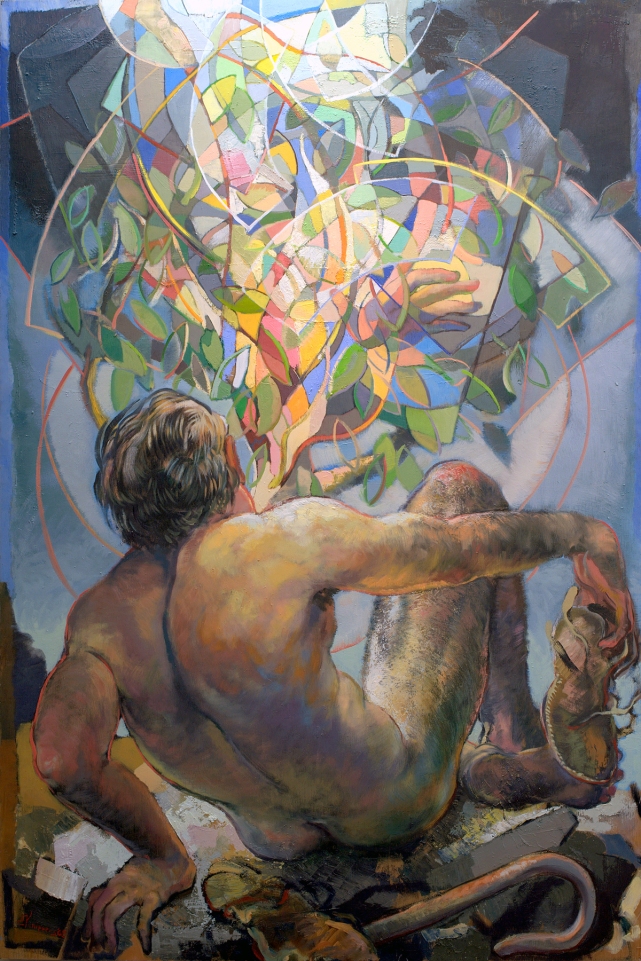“Open my eyes, that I may behold wondrous things . . .”—Psalm 119:18
“My own eyes are not enough for me, I will see through those of others.”—C. S. Lewis
Images have revelatory power. God spoke through them in ancient times: a ladder (Jacob); sheaves of wheat (Joseph); a ripe grapevine (pharaoh’s cupbearer); birds eating cake (pharaoh’s baker); cattle eating cattle (pharaoh); a wheel inside a wheel (Ezekiel); dry bones reconstituting into living human beings (Ezekiel); a broken statue (Nebuchadnezzar); four beasts (Daniel); a sheet filled with animals (Peter); and fantastical creatures doing battle (John). Some of these images were received during sleep, while others were waking dreams—visions—and while verbal statements by God sometimes accompanied them, the images left definite impressions that plunged the seer into a deeper awareness of God’s nature and/or will.

Another famous image through which God spoke was the burning bush on Mount Horeb, which interrupted Moses during his workday. Notice his double take:
Now Moses was keeping the flock of his father-in-law, Jethro, the priest of Midian, and he led his flock to the west side of the wilderness and came to Horeb, the mountain of God. And the angel of the Lord appeared to him in a flame of fire out of the midst of a bush. He looked, and behold, the bush was burning, yet it was not consumed. And Moses said, “I will turn aside to see this great sight, why the bush is not burned.” When the Lord saw that he turned aside to see, God called to him out of the bush, “Moses, Moses!” And he said, “Here I am.” (Exodus 3:1–4)
In Abiding: The Archbishop of Canterbury’s Lent Book 2013, Ben Quash notes that when Moses first sees the bush, he simply receives the visual data: bush on fire. But then as he starts to compute what he sees he realizes that hey, the flames are engulfing it, but it’s not being consumed; this is a “great sight” that deserves a closer look. So he turns aside from his intended path to dwell more consciously and deliberately with the strange bush. It is only then—when Moses has stood still long enough—that the voice of God addresses him. And he is utterly transformed by the encounter that follows, whereby he is called to liberate his people from slavery in Egypt and lead them in settling a new land.
The story of Moses’s divine calling suggests that God rewards attentiveness; he is present to those who take time to slow down and notice things.
In his foreword to Imaging the Word: An Arts and Lectionary Resource, Volume 3, Sidney D. Fowler urges us to be on the lookout for present-day burning bushes:
Before God had a name, God was seen and heard in the desert bush that burned. God appeared in vivid reds and golds, in the blazing crackles and hisses, in the image. God was not the bush nor the flame, but through and in both, God was known. Moses saw and heard God.
Unless we recognize God when God reaches into this world, do we truly know the Holy One? Often we do not expect God to come into our world—even though here God has acted since the time of creation. Today one may recognize God in nature as Moses did, but God may also be discerned in an abundance of other images, including the media, the arts, and the experiences of daily living. We are wise not to mistake an image for God. We are careful not to assume the holy in every image. But unless we are attentive to the world around us, we proceed without gazing into any image at all. We may pass a burning bush from which God beckons us.
We are confronted with visual stimuli all the time. But how often do we really stop to gaze, to contemplate what’s in front of us?

Artists know how to gaze. Their profession is predicated on their ability to see deeply into things, and to effectively present to us that vision. Their commitment to deep seeing is a tremendous service to us all, because it teaches us to do the same. By giving us an object to focus on, the artist provides a quiet, contemplative space where truth is free to bubble up to the surface.
When we read scripture, we often ask God to illuminate it for us, to make us receptive to what it has to teach; so too when we sit down to hear a sermon. We can approach art in much the same way. That’s not to say that images are on a par with the Bible but that they, like countless other things—the word of a friend (or an enemy), a cup of coffee, a day at the beach (or at the hospital)—can be conduits of divine grace and revelation. God’s ultimate self-disclosure is through scripture, but he has other ways of getting to us.
My prayer is that this website helps you cultivate the habit of contemplative seeing—that as your eyes and mind linger on works of art, your love for God and neighbor is increased, and that that impels you to go out into the world as persons of truth and grace.

I’m literally in love with this web cite!
LikeLike
HUMBLED and affirmed. Have been researching deeper information insight into God through Exodus 3 and His encounter with Moses. I want to do a triptych. Your website gives me more eyes and hearts to inspire. Thanks.
LikeLike